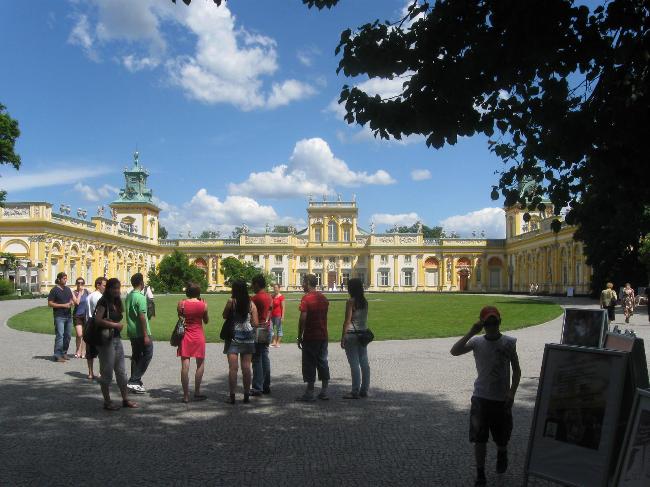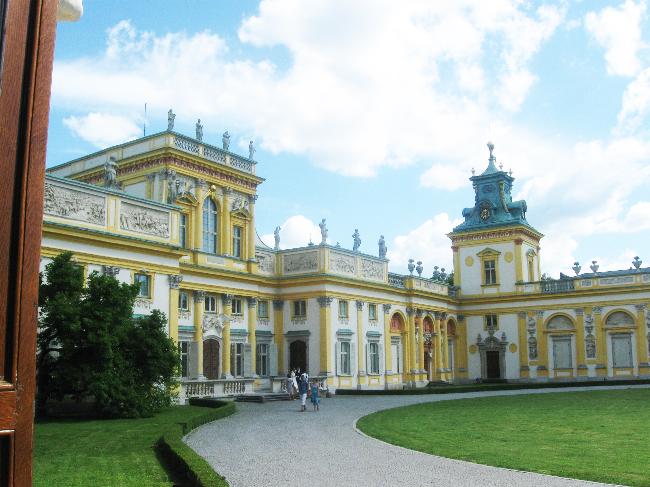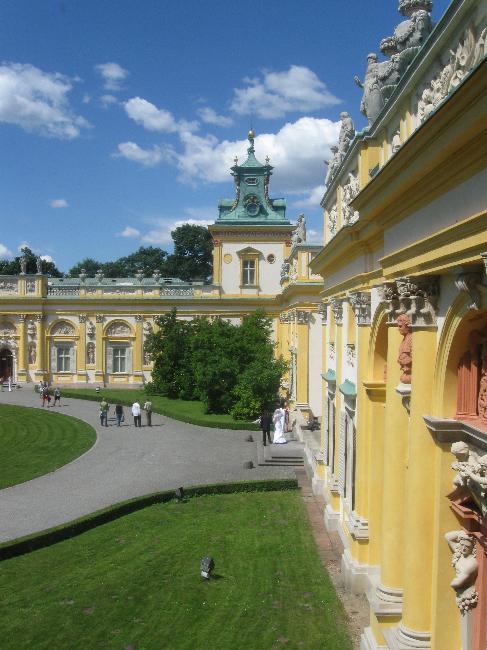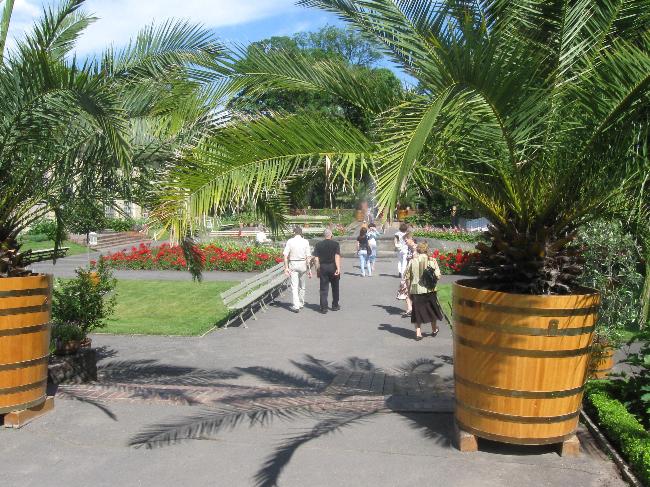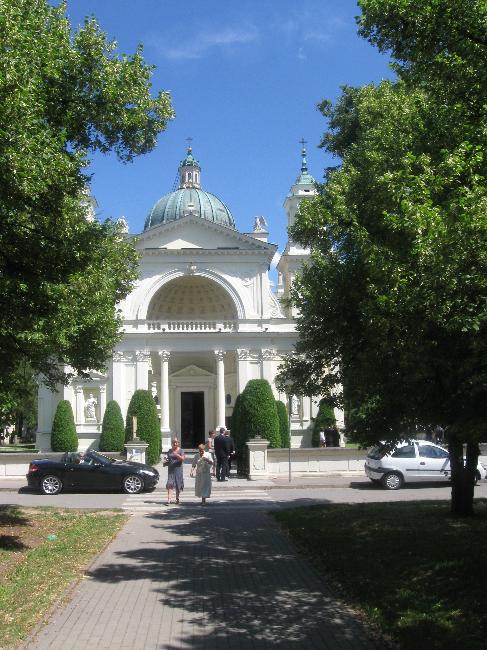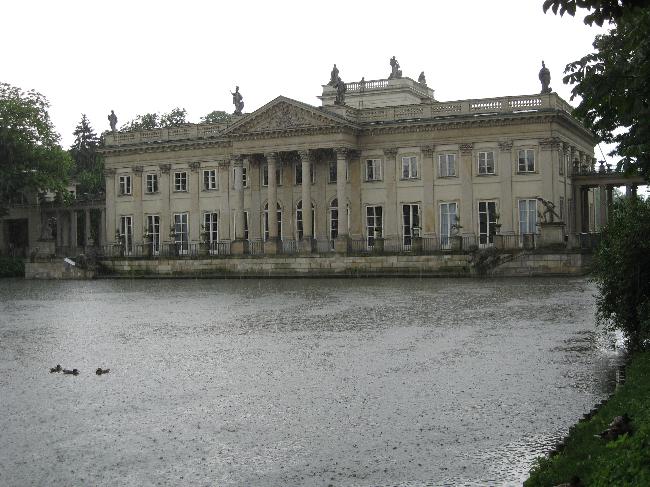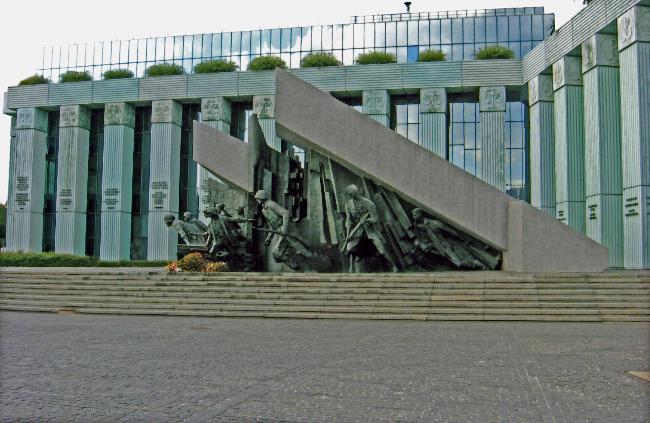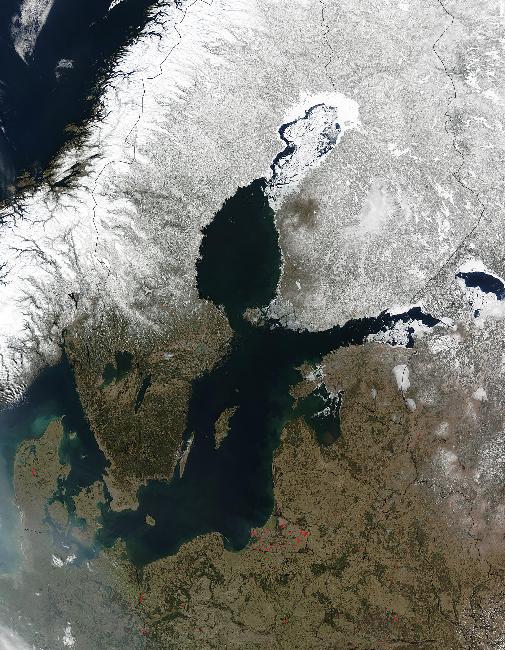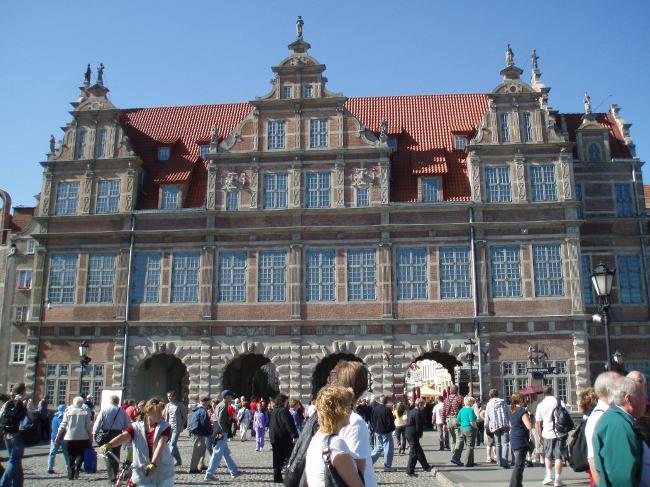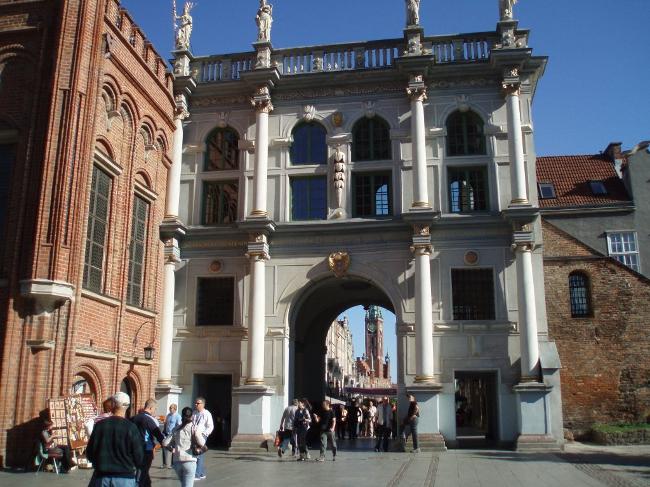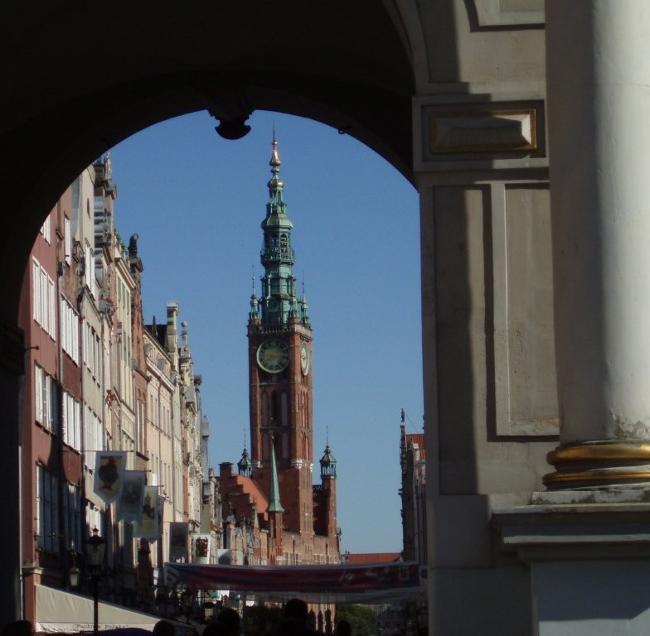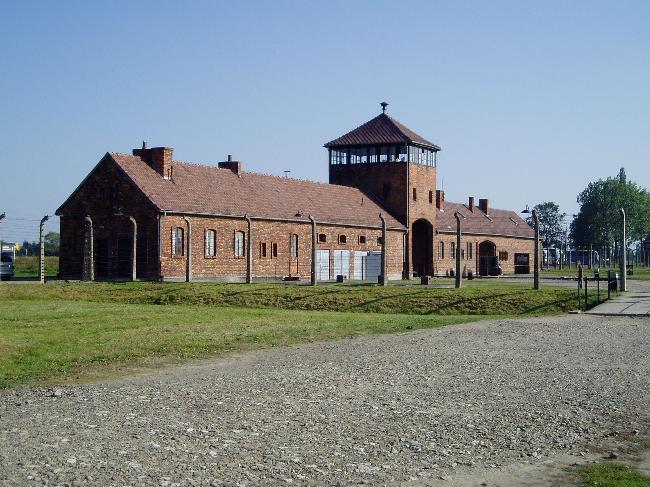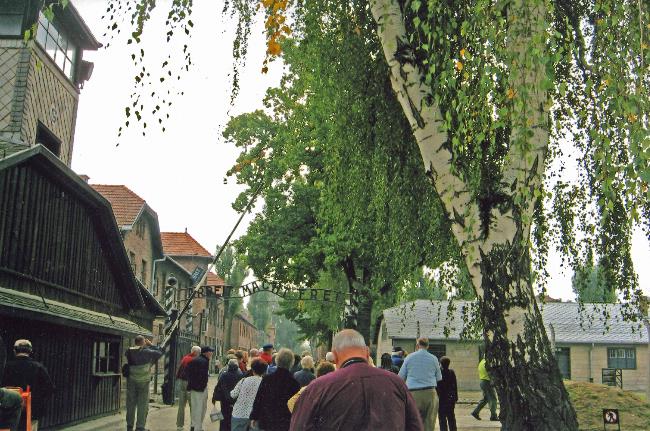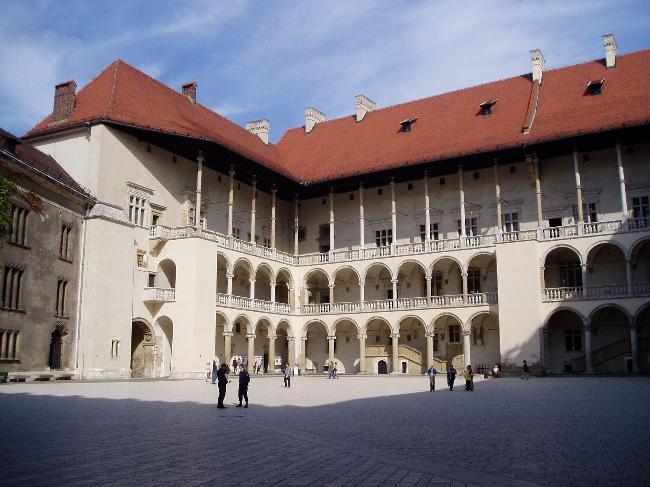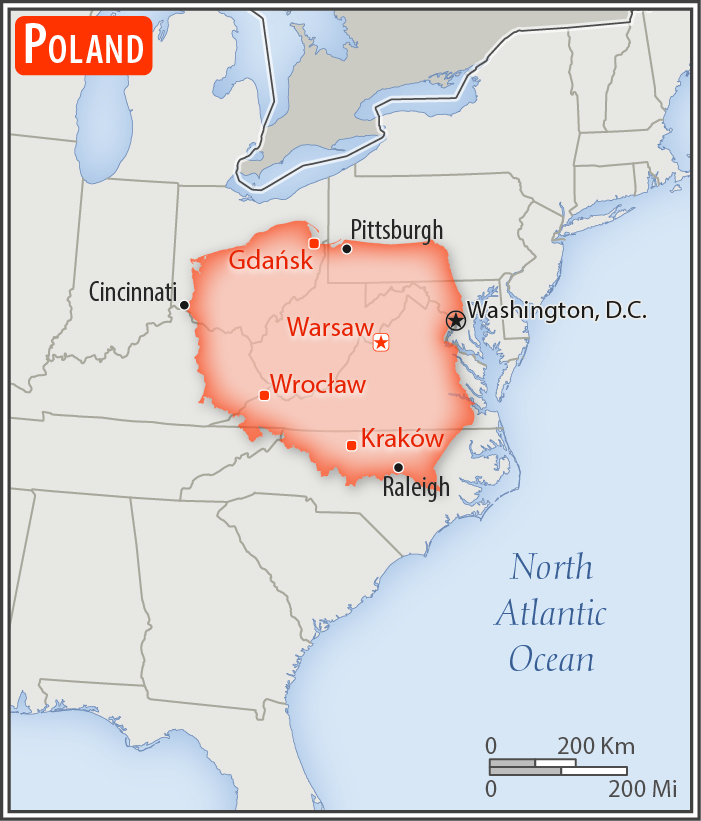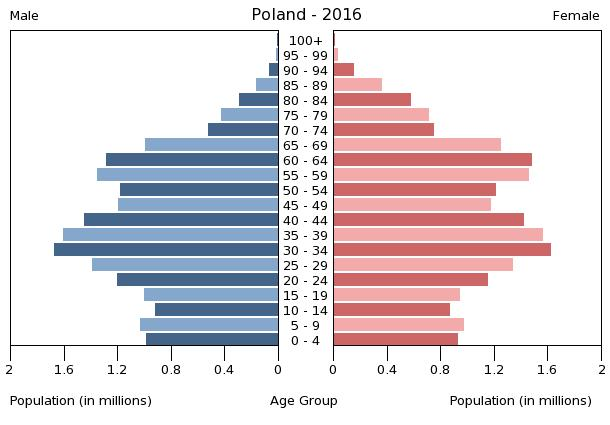Introduction :: POLAND
-
Poland's history as a state began near the middle of the 10th century. By the mid-16th century, the Polish-Lithuanian Commonwealth ruled a vast tract of land in Central and Eastern Europe. During the 18th century, internal disorders weakened the nation, and in a series of agreements between 1772 and 1795, Russia, Prussia, and Austria partitioned Poland among themselves. Poland regained its independence in 1918 only to be overrun by Germany and the Soviet Union in World War II. It became a Soviet satellite state following the war, but its government was comparatively tolerant and progressive. Labor turmoil in 1980 led to the formation of the independent trade union "Solidarity" that over time became a political force with over 10 million members. Free elections in 1989 and 1990 won Solidarity control of the parliament and the presidency, bringing the communist era to a close. A "shock therapy" program during the early 1990s enabled the country to transform its economy into one of the most robust in Central Europe. Poland joined NATO in 1999 and the EU in 2004. With its transformation to a democratic, market-oriented country largely completed and with large investments in defense, energy, and other infrastructure, Poland is an increasingly active member of Euro-Atlantic organizations.
Geography :: POLAND
-
Central Europe, east of Germany
52 00 N, 20 00 E
Europe
total: 312,685 sq km
land: 304,255 sq km
water: 8,430 sq km
country comparison to the world: 70
about twice the size of Georgia; slightly smaller than New Mexico
Area comparison map:

Europe
::POLAND

Area Comparison
about twice the size of Georgia; slightly smaller than New Mexico
total: 3,071 km
border countries (7): Belarus 418 km, Czech Republic 796 km, Germany 467 km, Lithuania 104 km, Russia (Kaliningrad Oblast) 210 km, Slovakia 541 km, Ukraine 535 km
440 km
territorial sea: 12 nm
exclusive economic zone: defined by international treaties
temperate with cold, cloudy, moderately severe winters with frequent precipitation; mild summers with frequent showers and thundershowers
mostly flat plain; mountains along southern border
mean elevation: 173 m
elevation extremes: lowest point: near Raczki Elblaskie -2 m
highest point: Rysy 2,499 m
coal, sulfur, copper, natural gas, silver, lead, salt, amber, arable land
agricultural land: 48.2%
arable land 36.2%; permanent crops 1.3%; permanent pasture 10.7%
forest: 30.6%
other: 21.2% (2011 est.)
970 sq km (2012)
population concentrated in the southern (Krakow) and central (Warsaw, Lodz) areas, with an extension to the northern coastal city of Gdansk
flooding
decreased emphasis on heavy industry and increased environmental concern by post-communist governments has improved environment; air pollution remains serious because of emissions from coal-fired power plants and the resulting acid rain has caused forest damage; water pollution from industrial and municipal sources is also a problem, as is disposal of hazardous wastes
party to: Air Pollution, Antarctic-Environmental Protocol, Antarctic-Marine Living Resources, Antarctic Seals, Antarctic Treaty, Biodiversity, Climate Change, Climate Change-Kyoto Protocol, Desertification, Endangered Species, Environmental Modification, Hazardous Wastes, Law of the Sea, Marine Dumping, Ozone Layer Protection, Ship Pollution, Wetlands
signed, but not ratified: Air Pollution-Nitrogen Oxides, Air Pollution-Persistent Organic Pollutants, Air Pollution-Sulfur 94
historically, an area of conflict because of flat terrain and the lack of natural barriers on the North European Plain
People and Society :: POLAND
-
38,523,261 (July 2016 est.)
country comparison to the world: 35
noun: Pole(s)
adjective: Polish
Polish 96.9%, Silesian 1.1%, German 0.2%, Ukrainian 0.1%, other and unspecified 1.7%
note: represents ethnicity declared first (2011 est.)
Polish (official) 98.2%, Silesian 1.4%, other 1.1%, unspecified 1.3%
note: data represents the language spoken at home; shares sum to more than 100% because some respondents gave more than one answer on the census; Poland ratified the European Charter for Regional or Minority Languages in 2009 recognizing Kashub as a regional language, Czech, Hebrew, Yiddish, Belarusian, Lithuanian, German, Armenian, Russian, Slovak, and Ukrainian as national minority languages, and Karaim, Lemko, Romani (Polska Roma and Bergitka Roma), and Tatar as ethnic minority languages (2011 est.)
Catholic 87.2% (includes Roman Catholic 86.9% and Greek Catholic, Armenian Catholic, and Byzantine-Slavic Catholic .3%), Orthodox 1.3% (almost all are Polish Autocephalous Orthodox), Protestant 0.4% (mainly Augsburg Evangelical and Pentacostal), other 0.4% (includes Jehovah's Witness, Buddhist, Hare Krishna, Gaudiya Vaishnavism, Muslim, Jewish, Mormon), unspecified 10.8% (2012 est.)
0-14 years: 14.72% (male 2,915,840/female 2,754,098)
15-24 years: 11.11% (male 2,195,587/female 2,082,634)
25-54 years: 43.5% (male 8,456,789/female 8,301,167)
55-64 years: 14.42% (male 2,623,838/female 2,931,215)
65 years and over: 16.26% (male 2,460,648/female 3,801,445) (2016 est.)
population pyramid:

Europe
::POLAND

Population Pyramid
A population pyramid illustrates the age and sex structure of a country's population and may provide insights about political and social stability, as well as economic development. The population is distributed along the horizontal axis, with males shown on the left and females on the right. The male and female populations are broken down into 5-year age groups represented as horizontal bars along the vertical axis, with the youngest age groups at the bottom and the oldest at the top. The shape of the population pyramid gradually evolves over time based on fertility, mortality, and international migration trends.
For additional information, please see the entry for Population pyramid on the Definitions and Notes page under the References tab.
total dependency ratio: 43.8%
youth dependency ratio: 21.5%
elderly dependency ratio: 22.3%
potential support ratio: 4.5% (2015 est.)
total: 40.3 years
male: 38.6 years
female: 42 years (2016 est.)
country comparison to the world: 46
-0.11% (2016 est.)
country comparison to the world: 209
9.6 births/1,000 population (2016 est.)
country comparison to the world: 202
10.3 deaths/1,000 population (2016 est.)
country comparison to the world: 39
-0.4 migrant(s)/1,000 population (2016 est.)
country comparison to the world: 123
population concentrated in the southern (Krakow) and central (Warsaw, Lodz) areas, with an extension to the northern coastal city of Gdansk
urban population: 60.5% of total population (2015)
rate of urbanization: -0.1% annual rate of change (2010-15 est.)
WARSAW (capital) 1.722 million; Krakow 760,000 (2015)
at birth: 1.06 male(s)/female
0-14 years: 1.06 male(s)/female
15-24 years: 1.05 male(s)/female
25-54 years: 1.02 male(s)/female
55-64 years: 0.9 male(s)/female
65 years and over: 0.64 male(s)/female
total population: 0.94 male(s)/female (2016 est.)
27.2 (2013 est.)
3 deaths/100,000 live births (2015 est.)
country comparison to the world: 175
total: 4.5 deaths/1,000 live births
male: 4.8 deaths/1,000 live births
female: 4 deaths/1,000 live births (2016 est.)
country comparison to the world: 182
total population: 77.6 years
male: 73.7 years
female: 81.7 years (2016 est.)
country comparison to the world: 70
1.34 children born/woman (2016 est.)
country comparison to the world: 215
6.4% of GDP (2014)
country comparison to the world: 89
2.22 physicians/1,000 population (2012)
6.5 beds/1,000 population (2011)
improved:
urban: 99.3% of population
rural: 96.9% of population
total: 98.3% of population
unimproved:
urban: 0.7% of population
rural: 3.1% of population
total: 1.7% of population (2015 est.)
improved:
urban: 97.5% of population
rural: 96.7% of population
total: 97.2% of population
unimproved:
urban: 2.5% of population
rural: 3.3% of population
total: 2.8% of population (2015 est.)
0.07% (2014 est.)
country comparison to the world: 115
NA
NA
degree of risk: intermediate
vectorborne disease: tickborne encephalitis (2016)
27% (2014)
country comparison to the world: 56
4.9% of GDP (2013)
country comparison to the world: 65
definition: age 15 and over can read and write
total population: 99.8%
male: 99.9%
female: 99.7% (2015 est.)
total: 16 years
male: 16 years
female: 17 years (2013)
total: 23.9%
male: 22.7%
female: 25.5% (2014 est.)
country comparison to the world: 34
Government :: POLAND
-
conventional long form: Republic of Poland
conventional short form: Poland
local long form: Rzeczpospolita Polska
local short form: Polska
etymology: name derives from the Polanians, a west Slavic tribe that united several surrounding Slavic groups (9th-10th centuries A.D.) and who passed on their name to the country; the name of the tribe likely comes from the Slavic "pole" (field or plain), indicating the flat nature of their country
parliamentary republic
name: Warsaw
geographic coordinates: 52 15 N, 21 00 E
time difference: UTC+1 (6 hours ahead of Washington, DC, during Standard Time)
daylight saving time: +1hr, begins last Sunday in March; ends last Sunday in October
16 provinces (wojewodztwa, singular - wojewodztwo); Dolnoslaskie (Lower Silesia), Kujawsko-Pomorskie (Kuyavia-Pomerania), Lodzkie (Lodz), Lubelskie (Lublin), Lubuskie (Lubusz), Malopolskie (Lesser Poland), Mazowieckie (Masovia), Opolskie (Opole), Podkarpackie (Subcarpathia), Podlaskie, Pomorskie (Pomerania), Slaskie (Silesia), Swietokrzyskie (Holy Cross), Warminsko-Mazurskie (Warmia-Masuria), Wielkopolskie (Greater Poland), Zachodniopomorskie (West Pomerania)
11 November 1918 (republic proclaimed); notable earlier dates: 966 (adoption of Christianity, traditional founding date), 1 July 1569 (Polish-Lithuanian Commonwealth created)
Constitution Day, 3 May (1791)
history: several previous; latest adopted 2 April 1997, approved by referendum 25 May 1997, effective 17 October 1997
amendments: proposed by at least one-fifth of Sejm deputies, by the Senate, or by the president of the republic; passage requires at least two-thirds majority vote in the Sejm and absolute majority vote in the Senate; amendments to articles relating to sovereignty, personal freedoms, and constitutional amendment procedures also require passage by majority vote in a referendum; amended 2006, 2009, 2015 (2016)
civil law system; judicial review of legislative, administrative, and other governmental acts; constitutional law rulings of the Constitutional Tribunal are final
accepts compulsory ICJ jurisdiction with reservations; accepts ICCt jurisdiction
citizenship by birth: no
citizenship by descent only: both parents must be citizens of Poland
dual citizenship recognized: no
residency requirement for naturalization: 5 years
18 years of age; universal
chief of state: President Andrzej DUDA (since 6 August 2015)
head of government: Prime Minister Beata SZYDLO (since 16 November 2015); Deputy Prime Minister and Minister of Culture and National Heritage Piotr GLINSKI (since 16 November 2015), Deputy Prime Minister and Minister of Science and Higher Education Jaroslaw GOWIN (since 16 November 2015), and Deputy Prime Minister and Minister of Development Mateusz MORAWIECKI (since 16 November 2015)
cabinet: Council of Ministers proposed by the prime minister, appointed by the president, and approved by the Sejm
elections/appointments: president directly elected by absolute majority popular vote in 2 rounds if needed for a 5-year term (eligible for a second term); election last held on 10 and 24 May 2015 (next to be held in 2020); prime minister, deputy prime ministers, and Council of Ministers appointed by the president and confirmed by the Sejm
election results: Andrzej DUDA elected president; percent of vote in runoff - Andrzej DUDA 51.5%, Bronislaw KOMOROWSKI (independent) 48.5%
description: bicameral legislature consists of the Senate or Senat (100 seats; members directly elected in single-seat constituencies by simple majority vote to serve 4-year terms) and the Sejm (460 seats; members directly elected in multi-seat constituencies by proportional representation vote to serve 4-year terms); note - the designation National Assembly or Zgromadzenie Narodowe is only used on those rare occasions when the two houses meet jointly
note: the German minority is exempt from the 5% threshold requirement for seats to the Sejm
elections: Senate - last held on 25 October 2015 (next to be held in October 2019); Sejm - last held on 25 October 2015 (next to be held in October 2019)
election results: Senate - percent of vote by party - NA; seats by party - PiS 62, PO 33, PSL 1, independents 4; Sejm - percent of vote by party - PiS 37.6%, PO 24.1%, K15 8.8%, N 7.6%, PSL 5.1% other 16.8%; seats by party - PiS 234, PO 138, K15 40, N 29, PSL 16, independent 2, German minority 1
highest court(s): Supreme Court or Sad Najwyzszy (consists of the president of the Supreme Court and 116 judges organized in criminal, civil, labor and social insurance, and military chambers)
judge selection and term of office: president of the Supreme Court nominated by the General Assembly of the Supreme Court and selected by the president of Poland; other judges nominated by the 25-member National Judiciary Council, and appointed by the president of Poland; judges appointed until retirement, usually at age 65, but tenure can be extended
subordinate courts: Constitutional Tribunal; regional and appellate courts subdivided into military, civil, criminal, labor, and family courts
Civic Platform or PO [Grzegorz SCHETYNA, chairperson; Slawomir NEUMANN, parliamentary caucus leader]
Congress of the New Right or KNP [Michal MARUSIK, chairman]
Democratic Left Alliance or SLD [Wlodzimierz CZARZASTY, chairman]
German Minority of Lower Silesia or MNSO [Ryszard GALLA, representative]
Kukiz 15 [Pawel KUKIZ; chairman, parliamentary caucus leader]
Law and Justice or PiS [Jaroslaw KACZYNSKI, chairman; Ryszard TERLECKI, parliamentary caucus leader]
Nowoczesna ("Modern") or N [Ryszard PETRU; chairman, parliamentary caucus leader]
Polish People's Party or PSL [Wladyslaw KOSINIAK-KAMYSZ; chairman, parliamentary caucus leader]
Razem (Together) [no party chair, led by nine-member management board]
All Poland Trade Union Alliance or OPZZ [Jan GUZ] (trade union)
Independent Self-Governing Trade Union "Solidarity" [Piotr DUDA]
Roman Catholic Church [Archbishop Wojciech POLAK, Archbishop Stanislaw GADECKI]
Arctic Council (observer), Australia Group, BIS, BSEC (observer), CBSS, CD, CE, CEI, CERN, EAPC, EBRD, ECB, EIB, ESA, EU, FAO, IAEA, IBRD, ICAO, ICC (national committees), ICCt, ICRM, IDA, IEA, IFC, IFRCS, IHO, ILO, IMF, IMO, IMSO, Interpol, IOC, IOM, IPU, ISO, ITSO, ITU, ITUC (NGOs), MIGA, MONUSCO, NATO, NEA, NSG, OAS (observer), OECD, OIF (observer), OPCW, OSCE, PCA, Schengen Convention, UN, UNCTAD, UNESCO, UNHCR, UNIDO, UNMIL, UNMISS, UNOCI, UNWTO, UPU, WCO, WFTU (NGOs), WHO, WIPO, WMO, WTO, ZC
chief of mission: Ambassador Ryszard SCHNEPF (since 28 September 2012)
chancery: 2640 16th Street NW, Washington, DC 20009
telephone: [1] (202) 234-3800 through 3802
FAX: [1] (202) 328-6271
consulate(s) general: Chicago, Los Angeles, New York
chief of mission: Ambassador Paul JONES (since 7 October 2015)
embassy: Aleje Ujazdowskie 29/31 00-540 Warsaw
mailing address: American Embassy Warsaw, US Department of State, Washington, DC 20521-5010 (pouch)
telephone: [48] (22) 504-2000
FAX: [48] (22) 504-2688
consulate(s) general: Krakow
two equal horizontal bands of white (top) and red; colors derive from the Polish emblem - a white eagle on a red field
note: similar to the flags of Indonesia and Monaco which are red (top) and white
white eagle; national colors: white, red
name: "Mazurek Dabrowskiego" (Dabrowski's Mazurka)
lyrics/music: Jozef WYBICKI/traditional
note: adopted 1927; the anthem, commonly known as "Jeszcze Polska nie zginela" (Poland Has Not Yet Perished), was written in 1797; the lyrics resonate strongly with Poles because they reflect the numerous occasions in which the nation's lands have been occupied
Economy :: POLAND
-
Poland has pursued a policy of economic liberalization since 1990 and Poland's economy was the only EU country to avoid a recession through the 2008-09 economic downturn. Although EU membership and access to EU structural funds have provided a major boost to the economy since 2004, GDP per capita remains significantly below the EU average and the unemployment rate is now below the EU average.
The government of Prime Minister Donald TUSK steered the Polish economy through the economic downturn by skillfully managing public finances and adopting controversial pension and tax reforms to further shore up public finances. While the Polish economy has performed well over the past five years, growth slowed in 2013 and picked back up in 2014-15. Poland’s new center-right Law and Justice government plans to introduce expansionary economic policies to spur long-term growth, but social spending programs are expected to lead to increased deficit spending over the medium term.
Poland faces several challenges, which include addressing some of the remaining deficiencies in its road and rail infrastructure, business environment, rigid labor code, commercial court system, government red tape, and burdensome tax system, especially for entrepreneurs. Additional long-term challenges include diversifying Poland’s energy mix and sources of supply, strengthening investments in innovation, research, and development, and as well as stemming the outflow of educated young Poles to other EU member states, especially in light of a coming demographic contraction due to emigration, persistently low fertility rates, and the aging of the Solidarity-era baby boom generation.
$1.052 trillion (2016 est.)
$1.02 trillion (2015 est.)
$984.4 billion (2014 est.)
note: data are in 2016 dollars
country comparison to the world: 25
$467.4 billion (2015 est.)
3.1% (2016 est.)
3.7% (2015 est.)
3.3% (2014 est.)
country comparison to the world: 90
$27,700 (2016 est.)
$26,800 (2015 est.)
$25,900 (2014 est.)
note: data are in 2016 dollars
country comparison to the world: 68
20.3% of GDP (2016 est.)
20.3% of GDP (2015 est.)
18.3% of GDP (2014 est.)
country comparison to the world: 81
household consumption: 57.4%
government consumption: 17.8%
investment in fixed capital: 19.8%
investment in inventories: 0.8%
exports of goods and services: 50.5%
imports of goods and services: -46.3% (2016 est.)
agriculture: 2.7%
industry: 38.5%
services: 58.9% (2016 est.)
potatoes, fruits, vegetables, wheat; poultry, eggs, pork, dairy
machine building, iron and steel, coal mining, chemicals, shipbuilding, food processing, glass, beverages, textiles
4.2% (2016 est.)
country comparison to the world: 49
17.78 million (2016 est.)
country comparison to the world: 36
agriculture: 12.6%
industry: 30.4%
services: 57% (2012)
9.6% (2016 est.)
10.5% (2015 est.)
country comparison to the world: 112
17.3% (2012 est.)
lowest 10%: 3.3%
highest 10%: 25.6% (2012 est.)
32.4 (2012)
33.7 (2008)
country comparison to the world: 108
revenues: $73.4 billion
expenditures: $86.56 billion (2016 est.)
15.7% of GDP (2016 est.)
country comparison to the world: 182
-2.8% of GDP (2016 est.)
country comparison to the world: 96
44.7% of GDP (2016 est.)
45% of GDP (2015 est.)
note: data cover general government debt, and includes debt instruments issued (or owned) by government entities other than the treasury; the data include treasury debt held by foreign entities, the data include subnational entities, as well as intra-government
country comparison to the world: 104
calendar year
-0.8% (2016 est.)
-1% (2015 est.)
country comparison to the world: 12
2.5% (31 December 2014)
1.5% (31 December 2013)
country comparison to the world: 109
5.1% (31 December 2016 est.)
4.92% (31 December 2015 est.)
country comparison to the world: 137
$186.6 billion (31 December 2016 est.)
$177.4 billion (31 December 2015 est.)
country comparison to the world: 26
$306.7 billion (31 December 2014 est.)
$318.8 billion (31 December 2013 est.)
country comparison to the world: 34
$344.8 billion (31 December 2016 est.)
$337.4 billion (31 December 2015 est.)
country comparison to the world: 34
$137.8 billion (31 December 2015 est.)
$168.9 billion (31 December 2014 est.)
$204.5 billion (31 December 2013 est.)
country comparison to the world: 38
-$250 million (2016 est.)
-$1.117 billion (2015 est.)
country comparison to the world: 90
$188.3 billion (2016 est.)
$190.8 billion (2015 est.)
country comparison to the world: 25
machinery and transport equipment 37.8%, intermediate manufactured goods 23.7%, miscellaneous manufactured goods 17.1%, food and live animals 7.6% (2012 est.)
Germany 27.1%, UK 6.8%, Czech Republic 6.6%, France 5.5%, Italy 4.8%, Netherlands 4.4% (2015)
$189.5 billion (2016 est.)
$188.4 billion (2015 est.)
country comparison to the world: 23
machinery and transport equipment 38%, intermediate manufactured goods 21%, chemicals 15%, minerals, fuels, lubricants, and related materials 9% (2011 est.)
Germany 27.6%, China 7.5%, Russia 7.2%, Netherlands 5.9%, Italy 5.2%, France 4.1% (2015)
$90.21 billion (31 December 2016 est.)
$94.91 billion (31 December 2015 est.)
country comparison to the world: 26
$344.8 billion (31 December 2016 est.)
$332.2 billion (31 December 2015 est.)
country comparison to the world: 32
$228.8 billion (31 December 2016 est.)
$221.8 billion (31 December 2015 est.)
country comparison to the world: 26
$64.62 billion (31 December 2016 est.)
$62.12 billion (31 December 2015 est.)
country comparison to the world: 40
zlotych (PLN) per US dollar -
4.056 (2016 est.)
3.7721 (2015 est.)
3.7721 (2014 est.)
3.1538 (2013 est.)
3.26 (2012 est.)
Energy :: POLAND
-
150 billion kWh (2014 est.)
country comparison to the world: 26
142 billion kWh (2014 est.)
country comparison to the world: 26
11 billion kWh (2014)
country comparison to the world: 20
14 billion kWh (2014 est.)
country comparison to the world: 13
36 million kW (2014 est.)
country comparison to the world: 29
89.5% of total installed capacity (2013 est.)
country comparison to the world: 79
0% of total installed capacity (2013 est.)
country comparison to the world: 84
1.5% of total installed capacity (2013 est.)
country comparison to the world: 142
8.5% of total installed capacity (2013 est.)
country comparison to the world: 43
18,420 bbl/day (2015 est.)
country comparison to the world: 73
5,162 bbl/day (2015 est.)
country comparison to the world: 71
532,300 bbl/day (2015 est.)
country comparison to the world: 19
100 million bbl (1 January 2010 es)
country comparison to the world: 69
568,200 bbl/day (2015 est.)
country comparison to the world: 31
536,700 bbl/day (2015 est.)
country comparison to the world: 33
160,100 bbl/day (2015 est.)
country comparison to the world: 38
128,800 bbl/day (2015 est.)
country comparison to the world: 44
6.08 billion cu m (2014 est.)
country comparison to the world: 49
17.66 billion cu m (2014 est.)
country comparison to the world: 41
76 million cu m (2014 est.)
country comparison to the world: 48
11.82 billion cu m (2014 est.)
country comparison to the world: 24
81.66 billion cu m (1 January 2016 es)
country comparison to the world: 56
322 million Mt (2013 est.)
country comparison to the world: 20
Communications :: POLAND
-
total subscriptions: 4.245 million
subscriptions per 100 inhabitants: 11 (July 2015 est.)
country comparison to the world: 30
total: 56.838 million
subscriptions per 100 inhabitants: 147 (July 2015 est.)
country comparison to the world: 26
general assessment: modernization of the telecommunications network has accelerated with market-based competition; fixed-line service, dominated by the former state-owned company, is dwarfed by the growth in mobile-cellular services
domestic: several nation-wide networks provide mobile-cellular service; coverage is generally good; fixed-line service lags in rural areas
international: country code - 48; international direct dialing with automated exchanges; satellite earth station - 1 with access to Intelsat, Eutelsat, Inmarsat, and Intersputnik (2015)
state-run public TV operates 2 national channels supplemented by 16 regional channels and several niche channels; privately owned entities operate several national TV networks and a number of special interest channels; many privately owned channels broadc (2007)
.pl
total: 26.221 million
percent of population: 68% (July 2015 est.)
country comparison to the world: 22
Transportation :: POLAND
-
number of registered air carriers: 6
inventory of registered aircraft operated by air carriers: 92
annual passenger traffic on registered air carriers: 4,841,128
annual freight traffic on registered air carriers: 120,016,466 mt-km (2015)
SP (2016)
126 (2013)
country comparison to the world: 47
total: 87
over 3,047 m: 5
2,438 to 3,047 m: 30
1,524 to 2,437 m: 36
914 to 1,523 m: 10
under 914 m: 6 (2013)
total: 39
1,524 to 2,437 m: 1
914 to 1,523 m: 17
under 914 m: 21 (2013)
6 (2013)
gas 14,198 km; oil 1,374 km; refined products 777 km (2013)
total: 19,837 km
broad gauge: 395 km 1.524-m gauge
standard gauge: 19,442 km 1.435-m gauge (11,899 km electrified) (2014)
country comparison to the world: 15
total: 412,035 km
paved: 280,719 km (includes 2,418 km of expressways)
unpaved: 131,316 km (2012)
country comparison to the world: 17
3,997 km (navigable rivers and canals) (2009)
country comparison to the world: 27
total: 9
by type: cargo 7, chemical tanker 1, passenger/cargo 1
registered in other countries: 106 (Antigua and Barbuda 2, Bahamas 34, Cyprus 24, Liberia 13, Malta 21, Saint Vincent and the Grenadines 3, Vanuatu 9) (2010)
country comparison to the world: 118
major seaport(s): Gdansk, Gdynia, Swinoujscie
river port(s): Szczecin (River Oder)
LNG terminal(s) (import): Swinoujscie
Military and Security :: POLAND
-
Polish Armed Forces: Land Forces, Navy, Air and Air Defense Aviation Forces, Special Forces (2013)
18-28 years of age for male and female voluntary military service; conscription phased out in 2009-12; service obligation shortened from 12 to 9 months in 2005; women only allowed to serve as officers and noncommissioned officers (2013)
2% of GDP (2016)
2.27% of GDP (2015)
1.95% of GDP (2014)
1.95% of GDP (2013)
1.91% of GDP (2012)
1.83% of GDP (2011)
country comparison to the world: 44
Transnational Issues :: POLAND
-
as a member state that forms part of the EU's external border, Poland has implemented the strict Schengen border rules to restrict illegal immigration and trade along its eastern borders with Belarus and Ukraine
refugees (country of origin): 12,304 (Russia) (2015); 71,302 applicants for forms of legal stay other than asylum (Ukraine) (2015)
stateless persons: 10,825 (2015)
despite diligent counternarcotics measures and international information sharing on cross-border crimes, a major illicit producer of synthetic drugs for the international market; minor transshipment point for Southwest Asian heroin and Latin American cocaine to Western Europe












